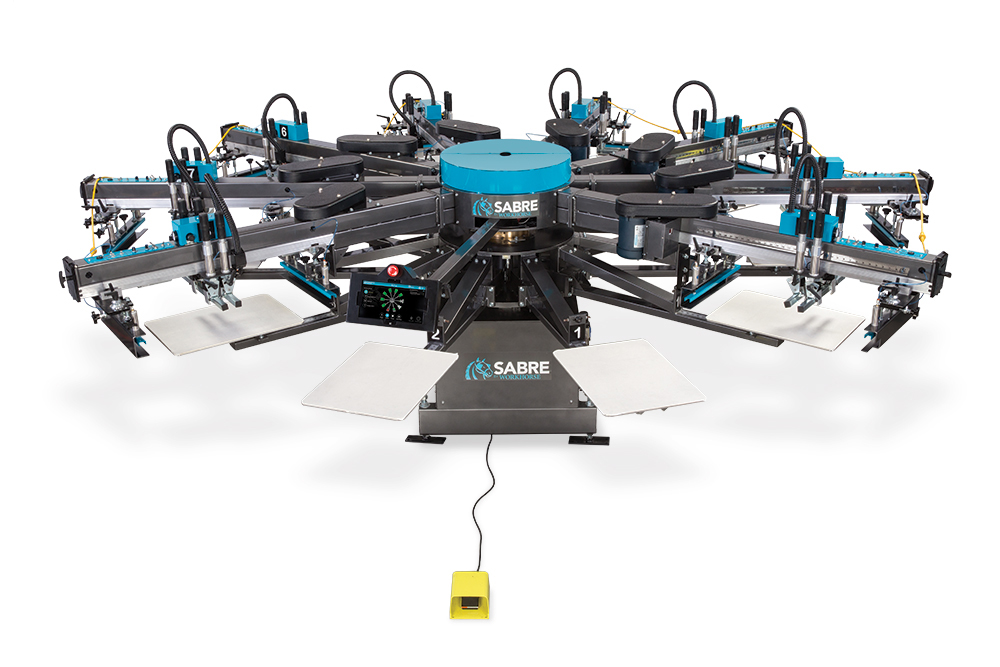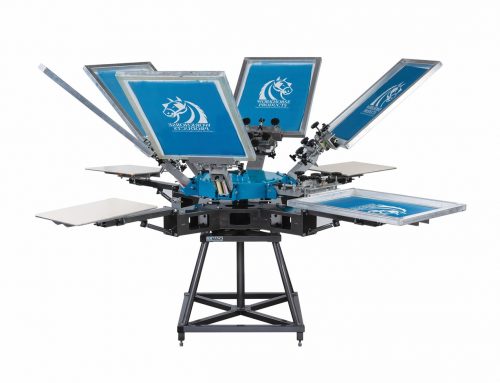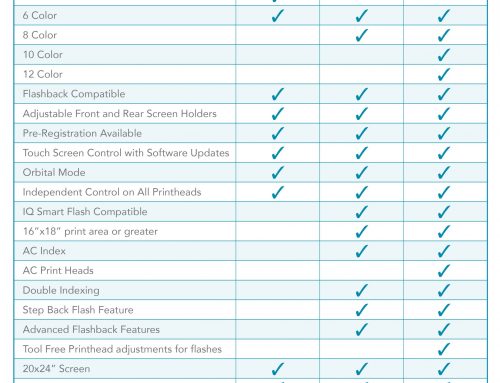Upgrading to an automatic press is no doubt a significant step in your business growth. Now that you’ve made that decision, it’s time to consider the ancillary items that go hand in hand with this upgrade. If you haven’t made the decision to purchase an automatic press, be sure to read the article in our March 2023 newsletter, 6 Reasons Why You Should Upgrade to and Automatic Press.
These ancillary items may seem less significant, but they play a crucial role in ensuring the efficient operation of your printing business. In this article, we’ll look into these products and explain their importance.
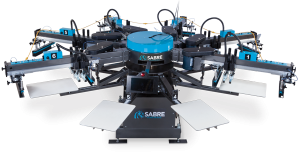
Compressor / Chiller
At a minimum, you will need a compressor that produces enough PSIs (pounds per square inch) and CFMs (cubic feet per minute) to properly handle the requirements of your auto press. At this time, you may even want to consider future purchases that require air. PSI is the amount of pressure that the air compressor can generate and is typically measured at the outlet of the compressor. CFM refers to the amount of air that is delivered at a given pressure and is typically used to evaluate airflow capacity. The higher the CFM, the longer it can power or operate without needing to recharge.
The chiller is a needed device for your compressor and offers several benefits. Essentially, it cools down the compressed air in your compressor, which reduces the operating temperature and improves the quality of the compressed air by eliminating moisture and contaminants that can cause damage to downstream equipment (specifically, your automatic press).
There are two common options when you purchase: piston-driven and screw-driven compressors. Piston-driven uses pistons and cylinders to compress air, while screw-driven uses rotating screws to compress air. The advantage of piston-driven is that they are less expensive with fewer moving parts; the disadvantage is that they are generally less efficient and produce more noise and heat, as well as consume more energy. Screw-driven are more expensive but offer the advantage of efficiency and performance – they can operate at a constant speed without overheating.
The choice between piston and screw compressors depends on the specific needs of your business.
Dryers / Flashes / Attachments
A crucial consideration is the need for a larger dryer. Automated printing significantly improves your output and you will need a dryer to handle the workload of these larger runs. A larger dryer will prevent bottlenecks in your production and increase the output capacity of your entire shop. Larger dryers can be powered by electricity or gas, and each offers a specific set of advantages. The topic of dryers is easily a stand-alone segment, so for this article, when considering a larger dryer, keep in mind the following: belt width, oven chamber, rate of production, and power source.
When deciding on a flash, a key component is the balance between function and speed. Some flashes allow you preserve a printhead (color) by working in conjunction with it, but this option decreases output. Others work independently of the printhead and while you sacrifice a color, this setup maximizes your output. Ultimately, flashes need to be efficient and effective at meeting the specific requirements of the ink and garment you are printing on.
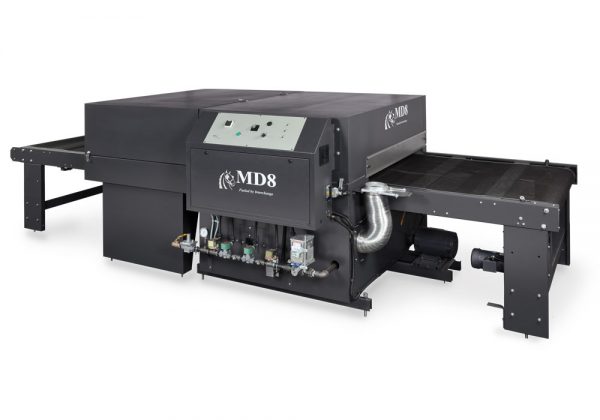
Printhead accessories is a topic rich in options, all offering specific functions and features. Let’s review a few:
Squeegees and flood bars come in a wide variety of sizes, which allows for ease of printing since not all of your prints are going to be the same width. You can also get different durometer (softness / hardness) squeegees for smoother application when using different types of inks and substrates.
Roller squeegees help to smooth the image by pushing fibers down into the ink. They can also help with the details and resolution of your image, along with providing a soft feel to your garment.
There are many stamping accessories, so we will quickly summarize some of the benefits in this category. You may be able to convert your automatic press into a transfer machine, replacing the need for a stand-alone space for this application. You can also use these accessories to smooth fibers, remove lint, and even flash your under base or colors.
Exposure Unit
Screens used on an automatic press are often larger in size, and because of this, the size of your exposure unit is also a factor to consider. With larger screens, you need a larger unit to ensure consistent and even exposures across the entire screen. In addition to the size, the power of the unit is also important. You may need faster burn times because of faster production times, the need for better image definition, or when using different types of emulsions (or even capillary films). These features provide a broader range of effects and finishes, increasing the range of products you can offer.
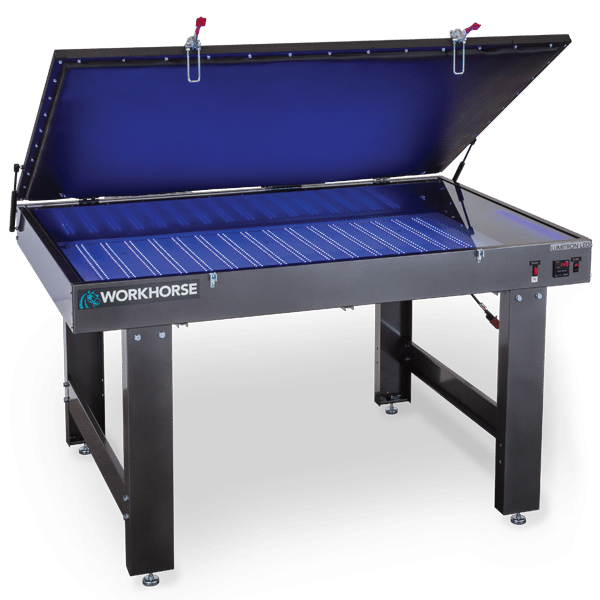
Screens / Screen Room
When automating your print shop, the choice of screens is important for achieving efficient and high quality production. We mentioned the different size requirement earlier, but other screen factors include tensions, types of frames, and image size. With automation, the size of your screen has much more impact in relation to the size of your print. For example, a 23”x31” screen will yield a 16”x18” print area, while an image with a 20” print area will need a 25”x36” screen.
Along with size considerations, tension is also a consideration. Auto machines often require screens with higher tension, which helps ensure precise registration. The higher tension can result in higher quality prints too. When it comes to screen types, there are static tension frames and retensionable screen frames. Static means you cannot retighten or stretch the mesh, but retensionable is just that – you can tighten the tension repeatedly as needed. Each option offers pros and cons, and both are good to consider when automating.
The addition of your automatic press should, at the very least, reduce the time you need to complete jobs, thereby allowing you to complete more jobs in a day. This increase in output may put a strain on your screen room capabilities, which is an important consideration as well. Adding more screens to your inventory may become necessary, along with expanding the area of your screen or dark room. By investing in this expansion, you can take full advantage of what the auto press provides.
Building / Utilities
A growing business usually requires a larger space with additional utility options such as increased electric (AMPS and PHASE) and natural gas availability. Again, at a minimum, you are looking for a production space big enough to fit your press and all other needed equipment. Now that you have more production, consider additional space that is needed for storage. A larger building can provide more storage space for inventory and raw materials, which can help reduce the risk of not having readily available what is needed to complete your jobs. Larger buildings may also come with higher costs, so carefully consider the financial implications to your business as well. By choosing an operating location that offers the right amount of space and access to necessary utilities, businesses can increase production capabilities, store more inventory, operate more efficiently, and potentially increase revenue.
Human Resources
Now, we’ll address the human factor. You will need to understand how automation will affect your workforce and implement strategies to mitigate possible negatives effects. Automatic machines can often work faster for longer periods of time without requiring breaks, Yet the press will only output at the speed of your operators. Therefore, your workforce may need to be reskilled or redeployed into new roles for success. Training may also be needed to ensure press operators have the skills and knowledge to operate the press efficiently and safely, and the maintenance of presses keeps the machines running properly while the productivity of employees and their safety is maintained.


